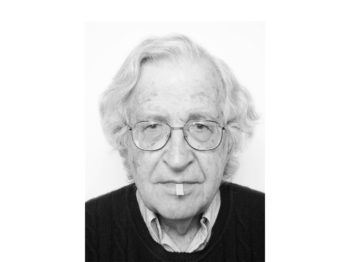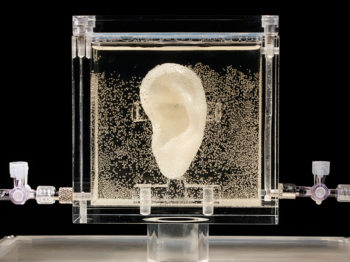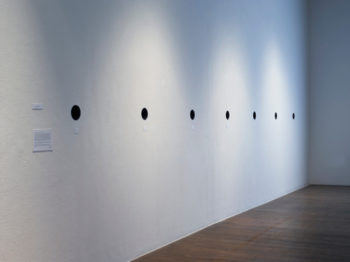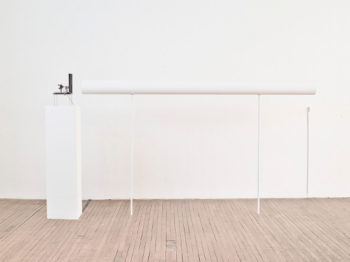
Diemut Strebe
2017-19 Ida Ely Rubin Artist in Residence
How to make a diamond disappear
About the Residency
Diemut Strebe, Ida Ely Rubin Artist in Residence at the MIT Center for Art, Science & Technology, and Brian L. Wardle, Professor of Aeronautics and Astronautics and the director of the necstlab and Nano-Engineered Composite aerospace STructures (NECST) Consortium, applied new research in engineered materials and structures to artworks. The necstlab research group’s mission is to lead the advancement and application of new knowledge at the forefront of materials and structures understanding, with contributions in both science and engineering.
The Redemption of Vanity is a 16-carat color diamond covered with a grown “forest” of carbon nanotubes (CNTs). The CNTs absorb 99.995 percent of light, creating the blackest black material on earth. Although the diamond and CNTs are the same element—carbon—the different atom lattice structure creates opposing extremes in appearance upon exposure to light, despite being comprised of the same object. The CNTs cast no shadows due to the substance’s unusual light-absorptive properties and therefore obscures its plasticity and three-dimensionality.
For Strebe and Wardle, the literal devaluation from a $2 million stone to a tiny black hole challenges the art market and explores how material and immaterial value is attached to objects and concepts in reference to luxury, society, and art.
Strebe has collaborated with several MIT faculty, including Noam Chomsky and Robert Langer on Sugababe (2014), Litmus (2014) and Yeast Expression (2015); Seth Lloyd and Dirk Englund on Wigner’s Friends (2014); Alan Guth on Plötzlich (2017); and researchers in William Tisdale’s Lab on The Origin of the Works of Art (2017).
Wardle has previously worked with CAST Visiting Artist Trevor Paglen on The Last Pictures project (2012).
Presented by the MIT Center for Art, Science & Technology (CAST), the MIT Department of Aeronautics and Astronautics and the MIT necstlab. The diamond in The Redemption of Vanity is from LJ West Diamonds.
This artist residency was supported by the Ida Ely Rubin Artists in Residence Fund.
Schedule
Past Event
The Redemption of Vanity
September 2019 – February 2020
New York Stock Exchange (NYSE)
11 Wall Street, New York, NY
On view by appointment only
The MIT Center for Art, Science & Technology (CAST) and the New York Stock Exchange (NYSE) present The Redemption of Vanity, created by artist Diemut Strebe in collaboration with MIT scientist Brian Wardle and his lab, on view at the New York Stock Exchange September 2019 – February 2020.
For the work, a 16.78 carat natural yellow diamond valued at $2 million from L.J.West Diamonds was coated using a new procedure of generating carbon nanotubes (CNTs), recently measured to be the blackest black ever created, which makes the diamond seem to disappear into an invisible void. The patented carbon nanotube technology (CNT) absorbs 99.995% of light and was developed by Professor Wardle and his necstlab lab at MIT.
“Any object covered with this CNT material loses all its plasticity and appears entirely flat, abbreviated/reduced to a black silhouette. In outright contradiction to this we see that a diamond, while made of the very same element (carbon) performs the most intense reflection of light on earth. Because of the extremely high light absorbtive qualities of the CNTs, any object, in this case a large diamond coated with CNT’s, becomes a kind of black hole absent of shadows,“ explains Strebe. “The unification of extreme opposites in one object and the particular aesthetic features of the CNTs caught my imagination for this art project.”
Collaborators at MIT
Brian L. Wardle, Professor of Aeronautics and Astronautics and Director of the necstlab and the Nano-Engineered Composite aerospace STructures (NECST) Consortium, MIT
Robert S. Langer, David H. Koch Institute Professor and Professor of Chemical Engineering and Biological Engineering, MIT
Estelle Cohen, Research Scientist, Department of Aeronautics and Astronautics, MIT
Dr. Luiz Acauan, Postdoctoral Associate, Department of Aeronautics and Astronautics, MIT
Ashley Kaiser, Graduate student, Department of Materials Science and Engineering, MIT
Biography
Diemut Strebe is a German-born artist based in Boston. Through a variety of styles and media, Strebe links art and science to address contemporary issues, often incorporating themes related to philosophy and literature. Strebe’s heterogeneous style results from the variety of topics and strands in science with which she works, as well as her conceptual approach.
Focused on the advanced science of our era, Strebe affirms the romantic paradigm of “the new” through the medium itself and its combination with art. She describes her practice as using the interface of science and art in the way that gravitational lensing has been used to trace unseen matter.
Strebe explores the crossover between science and art through media such as living and biological materials, experimental setups, installations and video. In her first art-science work, Sugababe (2014), she produced a clone of Vincent van Gogh’s ear. Through Sugababe, Strebe applied the Theseus paradox—a thought experiment based in Plutarch’s Ship of Theseus, which questions whether an object that has all its component parts replaced remains the same object. The work explores the potential and implications of re-creating a historical person and questions the mystification of art and the artist by the public and in art theory.
Strebe collaborates with scientists in the fields of human and plant genetics, quantum physics and astrophysics, and engineering, among others. Her practice includes scientific concepts, methods, and tools. She is represented by Ronald Feldman Fine Arts, New York.
More at the artist’s website: Diemut Strebe and on her project website.
In the Media
“She challenges art patrons to expand their ideas of genetic engineering, thinking about how science can be used on an artistic and conceptual level.”
“Strebe’s art-science collaboration caused us to look at the optical properties of our new CNT growth, and we discovered that these particular CNTs are blacker than all other reported materials by an order of magnitude across the visible spectrum.”
— Professor Wardle via ArtNet, September 2019
“Science can produce mediums for art, and perhaps art can give back to science.”
— CNN
99percentinvisible: Their Dark Materials
Press Release: MIT Art-Science Project Makes $2 Million Diamond “Disappear” at the NY Stock Exchange
MIT News: MIT engineers develop “blackest black” material to date
American Chemical Society (ACS) Applied Materials and Interfaces: Breakdown of Native Oxide Enables Multifunctional, Free-Form Carbon Nanotube–Metal Hierarchical Architectures
The Guardian: German museum exhibits Van Gogh’s ear replica grown from relative’s cells
The New York Times: An Unusual van Gogh Work at a German Museum – His Ear
Wall Street Journal: Vincent van Gogh’s 3-D Printed Ear on Display
BBC: Bringing Vincent van Gogh’s ear ‘back to life’
Artsy: Diemut Strebe’s Technologically Advanced Thought Experiments
artnet: German Museum Has a Living Copy of Van Gogh’s Famous Ear
Al Jazeera: German artist ‘regrows’ severed Van Gogh ear
artnet: Diemut Strebe: Free Radicals, Sugababe and Other Works
Architectural Digest: New Yorkers Can Find Out What Vincent van Gogh’s Severed Ear Actually Looked Like
Robb Report: This Artist Will Make a $2 Million Diamond Vanish in Plain Sight at the New York Stock Exchange
The Art Insider: New York Stock Exchange Will Witness An Artist Make $2 Million Diamond Disappear
ARTnews: An Artist Will Make a $2 M. Diamond Disappear in Plain Sight at the New York Stock Exchange
Art Critique: Artist Diemut Strebe shrouds a $2 million diamond in the ‘blackest black’, puts it at the New York Stock Exchange
Reusch Jewelers: Artist Diemut Strebe Will Make a 16.78-Carat Yellow Diamond Disappear in NYC
The Jeweler Blog: Artist Diemut Strebe Will Make a 16.78-Carat Yellow Diamond Disappear in NYC
Popular Mechanics: Scientists Create the Blackest Material Ever
The New York Times: Ultra-Black is the New Black












